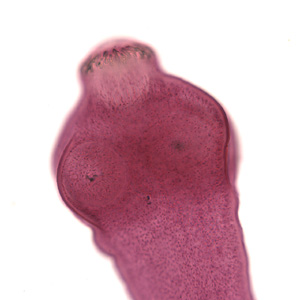Echinococcus granulosus
A Parasitic Tapeworm
Adaptations
 Each of the different stages of
development of E. granulosus has developed
adaptations to increase their survivability within their
host. For example, the oncosphere, the
earliest differentiated stage in the life cycle of the
cyclophyllidean tapeworm, develops six hooks to burrow
through the small intestine of the intermediate host in
order to gain access to the bloodstream. Adults
have developed four hooks on the scolex, located on the
anterior end of the organism, to attach themselves to the
intestinal wall of their definitive hosts.
Each of the different stages of
development of E. granulosus has developed
adaptations to increase their survivability within their
host. For example, the oncosphere, the
earliest differentiated stage in the life cycle of the
cyclophyllidean tapeworm, develops six hooks to burrow
through the small intestine of the intermediate host in
order to gain access to the bloodstream. Adults
have developed four hooks on the scolex, located on the
anterior end of the organism, to attach themselves to the
intestinal wall of their definitive hosts.
Due to the feeding practices of the Cestodes, absorbing most of the nutrients through their tegument, these organisms have adapted to maximize their surface area and minimized their volume. By having a large amount of surface area, it provides a larger area for nutrient absorption. With the small volume a circulatory system is not needed because the nutrients are absorbed close enough to the cells that they can diffuse throughout the tapeworm.
E. granulosus has also developed ways to detect tactile stimulation from the environment. Sensory organs, located at the anterior end within the scolex, are attached to longitudinal nerves that extend down the side of the organism. This allows the organism to respond to certain stimulations from the environment.
Parts of the reproductive system of E. granulosus have been adapted to increase the probability for the perpetuation of this species. In the adult, proglottids have developed to release the fertilized eggs into the intestine of the host. These proglottids are segments of the tapeworm that contain a complete set of both male and female reproductive organs, allowing it to self-fertilize when necessary. After becoming fertilized, the proglottids detach from the rest of the organism and release their eggs into the environment via the bowel movements of the host.